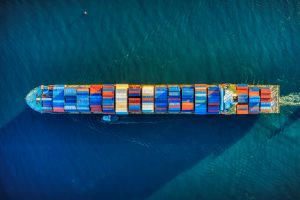4 The Historical and Cultural Impact of Ships and Sea Commerce
George Meyer
Keywords
- Merchant ship– A boat or vessel that carries cargo or passengers for hire
- Sea trade– The transport of goods across bodies of water
- Port– A destination for merchant ships to load and unload cargo
- Export-Heavy Countries– Countries that rely on the exporting of goods as a main share of their GDP
Learning Objectives
By the end of this chapter, you should be familiar with:
- Early forms of ships and boats
- Shipping and Trade in 17th century
- Modern cargo trade: Pros and Cons
- The Future of Sea Trade
Before the invention of the airplane, the automobile, and even before the invention of the railroad, there was but one means of transportation that connected the world: the boat. Water does make up about seventy-five percent of the earth’s surface, so the infrastructure for boating was already in place by the time the first water-faring vessels were built in 4000 BCE. Cities in the ancient world relied on water sources to provide food, water for crops, and drinking water, but proximity to a river or coastline also meant a quick means of travel. When humans discovered travel by way of water, a whole new world was opened to explore – Literally!
Every year, trillions of dollars in goods are transported by ships. The U.S. navy is so interested in protecting in protecting its trade waters that it plans to spend 718 billion dollars (about $2,200 per person in the US) from 2009-2038 constructing and acquiring new ships (An Analysis of the Navy’s Fiscal Year 2011 Shipbuilding Plan, 2010). Shipping continues to play a vital role in society. As humans have progressed and advanced, the world has become interconnected by ships and boats. In this chapter of the textbook, we will explore the history of ships and their impact on the world today, as well as look into the future of sea transport.
4.2 What is Sea Trade?
Key Takeaway
The creation of the ship connected the world on a global scale for the first time in the history of human civilization. Travel via land was possible, but ocean trade routes allowed for ships to cover hundreds of miles in mere days, not to mention the added benefit of stowing cargo. Sea trade, by definition, is the international transport of goods across oceans via vessels capable of stowing. Along with the economic benefit received from participants in oversea trade, intercontinental ships have allowed for the spread of culture across the world.
Today, the cargo ship industry is at its peak, with billions of dollars of cargo being shipped every day into ports, that is, designated coastal cities that specialize in the intake, export, and transfer of cargo. According to the Bureau of Transport Statistics’ annual report to congress on port performance (2021), “Waterborne vessels are the leading transportation mode for international freight, moving 41 percent of freight value in 2019—over $1.7 trillion… In 2019 the top 25 tonnage ports handled a total of 1.82 billion tons of cargo.” With the trend of consumer spending in the last century continuously moving upward, there seems to be no end in sight to commercial sea trade.
4.3 History of Sea Travel
Key Takeaway
How ships developed and their role in the past.
4.3.1 Early Vessels and Trade
The year was approximately 4000 BCE, Egypt was planted along the Nile in the fertile crescent and the civilization was still in its infancy. It was in this time that historians believe the first boats were created. Historians know this because of surviving clay tablets from the time, however, some sources indicate that the earliest boats could have been built as early as the 5th millennium BCE (Curley, 2012). The ships built in this period of history differed from the ships of the modern world. For one, early forms of ships relied entirely on raw human muscle to operate oars that would propel the ship forward, backward, and side to side. Later down the road, early boats would adopt rudimentary sails.
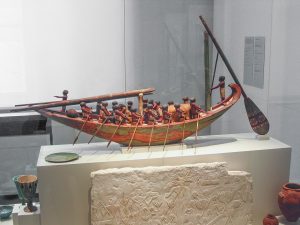
“Egyptian Boat Model” by Magnus Manske is licensed under CC BY-SA 3.0
Other civilizations found separate ways to develop their own unique types of sea-faring ships, each designed specifically to the needs of the people developing them. The Phoenicians were a trade-heavy civilizations, so they built ships with dimensions that could accommodate cargo. Moving into the 2nd millennia BCE, sailing ships began adopting a second mast to increase speed and efficiency. Improved craftsmanship allowed for boats with more efficient hulls that allowed for boats to move through the water better. Sailors found that by looking at the constellations in the night sky, they could estimate what cardinal direction they were headed.
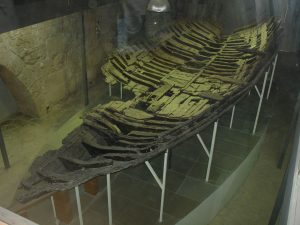
“Egyptian Boat Model” by Magnus Manske is licensed under CC BY-SA 3.0
Case Study
In 1968 and 1969, an archeological diving team uncovered the shipwreck of a Greek cargo ship off the north coast of Cypress near the town of Kyrenia. The ship was believed to have been wrecked in 1400 BCE. What was particularly interesting about the wreck was the cargo it was holding. The cargo retrieved in a recovery effort consisted of 400 jars of wine, millstones, coins, and a large copper cauldron. The cargo of the Greek ship indicates that at this point of time, trade networks were beginning to become established. Where the ship was traveling, historians can only speculate. Figure 1.1.2 shows an image of the shipwreck after it had been recovered.
Before widespread ease of travel, civilizations were often unaware of different societies. Being hundreds of miles away without any infrastructure or means of transportation meant people lived their lives in a small vicinity. The earliest record or inter-civilizational contact hails from an archaeological dig site near the Persian Gulf that was uncovered in the 1980s. Pottery and decorated objects found at the sites had aspects that indicated they derived from the Indus River Valley region, indicating the institution of a trade route via the Indian Ocean (Gould, 2011). The early link between civilization indicates the historical role ships played in connecting people of the ancient world. In the 21st century, the world seems much smaller than it did in the past. It is easy to take sea travel technology for granted when there are many other ways to travel faster and more efficiently. In the time of our ancestors, ships played a crucial role in allowing humans to not only explore the world more than was ever possible, but also exposing the societies and cultures of the world that would otherwise be unreachable. Ship building vastly improved in the centuries following the Ancient Era. The Romans and other civilizations of the Classic period created and designed their own versions of battle and trade ships, but ships had become vastly modernized by the end of the late Middle Ages and start of the Early Modern period.
4.3.2 Vessels and Sea Trade During the 17th century
In the 17th century, ships had vastly transformed from their earlier counterparts. Easier and cheaper means of production meant bigger, more widely produced ships. Ships in this period relied on large crews, upwards of 50 men. Countries in this period relied strongly on their merchant fleet to supply them with overseas goods. It was also in this period that European countries started to establish frequently used trade routes to the East and the New World. The spice trade was rampant and everyone with the ability to partake in it had some sort of foot in it, such as the English, Dutch, and the Spanish. According to Curly (2011, pg. 13) in his book on the history of ships, “Standard profits were 100 percent or more. In the accumulation of capital, by countries and by individuals, this mercantile activity was of the uttermost importance.” The Dutch experienced their own “golden age” in the 17th century due to their prowess in the market of merchant sea trade. The invention of the Dutch merchant ship, the Fluyt, played a large role in cementing the Netherlands as the leader in merchant trade. With a narrow body and dimensions specifically designed for carrying as much cargo as possible, the Fluyt dominated in terms of trade ship capability during the time. However, the Dutch would not hold control forever and power would soon be shifted to the English. According to Macdonald (2015), “Historians have long established that by the middle of the eighteenth century, the tumultuous seas of the North Atlantic had been transformed by and large into an English pond.” The importance of trade control would only increase into the current modern era.
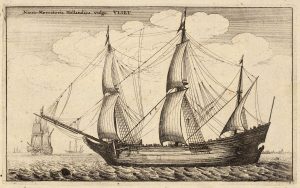
“The Kyrenia Ship” by Mgiganteus1 is licensed under CC BY-SA 3.0
4.4 Modern Sea Trade and Its Effects
Key Takeaway
Today, the cargo trade industry is worth trillions of dollars. Every nation of the world is reliant on overseas trade. We benefit from the interconnectedness of everything nowadays. Because of the cargo ship trade, we can enjoy products from all around the world that are much more abundant and cheaper because of established trade routes via ships and ports. However, with the increasing number of cargo ships in use every year, emissions from fossil fuels have increased as a direct result.
In the U.S. alone, the top 25 ports in tonnage handled approximately 1.82 billion tons of cargo in the 2019 period alone, with 703 million tons of domestic and 1.1 billion tons of foreign goods. The figure below shows the distribution of foreign and domestic cargo of several U.S. ports in terms of tonnage of cargo handled. (Bureau of Transport Statistics, 2021, pg. 16):
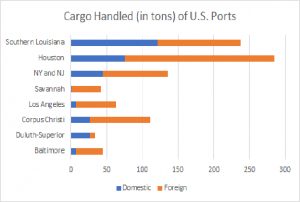
Created by George Meyer
The last 50 years of sea trade has allowed many countries to prosper. Export-heavy countries like China and Japan have benefited from their maritime transport industries. Sea trade has opened the world economy in a way that no other mode of transportation could fill. Cities on rivers and coastlines have proven to be the backbone of nations. Today, famous port cities, such as Singapore and Hong Kong, have reaped the rewards of sophisticated and integrated shipping routes. In the United States, cities such as Los Angeles, New York City, Chicago, and Charleston rely on their ports to supply the rest of their state with overseas cargo. According to Kaluza (et al, 2010), “The directed network of the entire cargo fleet is noticeably asymmetric, with 59 per cent of all linked pairs of ports being connected only in one direction. Still, the vast majority of ports (935 out of 951) belong to one single strongly connected component, i.e. for any two ports in this component, there are routes in both directions, though possibly visiting different intermediate ports.”
Despite the economic boom countries have experienced in the last century, cargo ships rely on petroleum to operate. Hundreds of thousands of barrels of oil are used up in the in the cargo shipping industry, and not only is petroleum a finite resource, but also produces emissions that contribute to global warming. According to Johnson (et al), “The main sources for particles and particle formation from shipping are NO2 and sulfur (of which more than 95 % is emitted as SO2 in the gas phase and the rest as sulfate particles). In addition, ash, EC (elemental carbon), and OC (organic carbon) are assumed to be emitted as primary particles” (2020).
4.5 The Future of Sea Commerce
Key Takeaway
The pivotal role that sea trade plays in society today indicates where the future of the technology is heading. It will be up to nations if they wish to continue to use fossil fuels to power ships in the future. Regarding the volume of trade ships operating in 2021, numbers will have to increase to accommodate for growing economies, especially in markets in Eastern Asia. Nations will have to continue to rely on the use of cargo shipping due to the lack of a better way. Research and development on alternative sources of energy is dependent on the ability to fund such projects.
In the past, ship locomotion derived from human muscle. Then from human derived energy to wind, then to steam, and then to petroleum in the modern era. It would be ignorant to say that ship technology has reached its peak, as petroleum is far from being the best means of power. Countries have been increasing their use of nuclear technologies employed to power ships. Currently, U.S. nuclear-powered submarines can operate without refueling for years on end. In the future, commercial cargo ships could transition to nuclear power if safer methods are developed to manage reactors. However, ships are large and prone to accidents. Wherever shipping technology moves in the future, it will no doubt continue to be an integral part of society.
Chapter Summary
Ships have played a significant role in connecting the world. It has connected cities thousands of miles apart to one another, and allowed for the creation of a global economy. Ships are one of, if not the oldest, means of transportation to date, with the first stirrings of ocean-faring vessels appearing in the 4th millennium. Today, ships continue to play an important role in the transport of commodities and resources, both domestically and internationally. As the years continue, ships and sea commerce will continue to play an integral part of society.
Review Questions
1. In 2019, how many tons of cargo were handled by the top 25 ports in the U.S.?
A. 990 million
B. 1.82 billion
C. 700 million
D. 1.34 billion
2. What motivated trans-continental sea travel in the 17th century?
A. Efficient and cheaper production of ships
B. Economic opportunity
C. Innovations of oar technology
D. A. and B
E. A. and C.
F. A., B., and C.
3. What ship allowed for the Dutch to take the lead in merchant trade in the 17th century?
A. The Fluyt
B. The Flying Dutchman
C. The Privateer
D. The Schooner
4. NO2 and sulfur make up what?
A. The lining of cargo ship containers
B. 3% of all the goods transported via freight each year
C. Most particle emissions from cargo ships
D. 37% of the atmosphere
Answers:
1. A
2. D
3. A
4. C
Food for Thought
How did ships connect the world of the past, and what is the role they play in economies today?
What changes do you think will be made to ships in the future to help deter climate change?
References
An analysis of the Navy’s fiscal year 2011 shipbuilding plan. (2010). Congress of the U.S., Congressional Budget Office.
Bureau of Transport Statistics, Port Performance Freight Statistics in 2019: Annual Report to Congress 2020 (2021).
Curley, R. (2012). The Complete History of Ships and Boats: From Sails and Oars to Nuclear-Powered Vessels. Britannica Educational Pub. in association with Rosen Educational Services.
Gould, R. A. (2011). Archaeology and the social history of ships (2nd ed.). Cambridge University Press.
Jonson, J. E., Gauss, M., Schulz, M., Jalkanen, J.-P., & Fagerli, H. (2020). Effects of global ship emissions on European Air Pollution Levels. Atmospheric Chemistry and Physics, 20(19), 11399–11422. https://doi.org/10.5194/acp-20-11399-2020
Kaluza, P., Kölzsch, A., Gastner, M. T., & Blasius, B. (2010). The complex network of global cargo ship movements. Journal of the Royal Society, Interface, 7(48), 1093–1103. https://doi.org/10.1098/rsif.2009.0495
McDonald. (2015). Pirates, merchants, settlers, and slaves: Colonial America and the Indo-Atlantic world (1st ed., Vol. 21). University of California Press. https://doi.org/10.1525/j.ctt130jt3q
The transport of goods across bodies of water.
A destination for merchant ships to load and unload cargo.
A boat or vessel that carries cargo or passengers for hire.
Countries that rely on the exporting of goods as a main share of their GDP.

